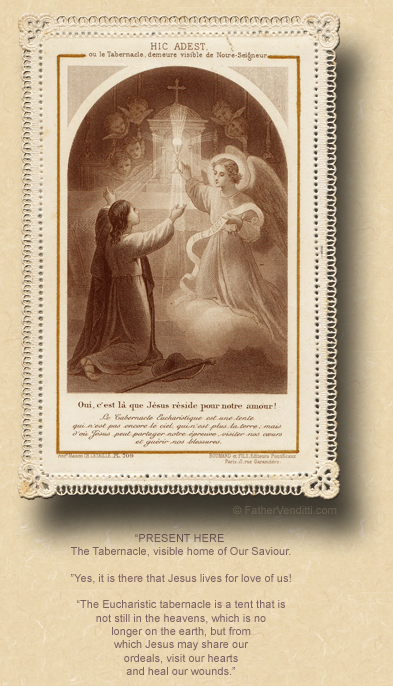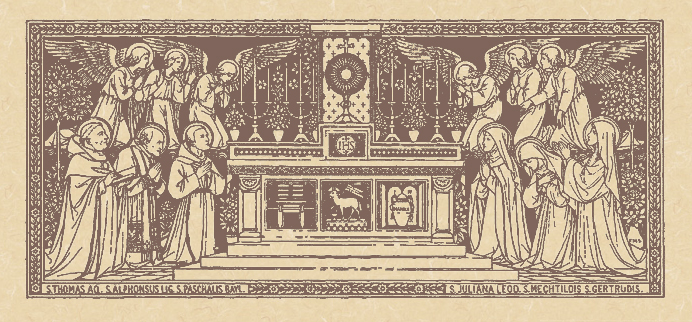Et introibo ad altare Dei.
The Twenty-Fifth Thursday of Ordinary Time; the Memorial of Saint Wenceslaus, Martyr; or, the Memorial of Saints Lawrence Ruiz & Companions, Martyrs.*
Lessons from the primary feria, according to the ordinary form of the Roman Rite:
• Haggai 1: 1-8.
• Psalm 149: 1-6, 9.
• Luke 9: 7-9. |
If a Mass for St. Wencelaus is taken, lessons from the feria as above, or from the proper:
• I Peter 3: 14-17.
• Psalm 126: 1-6.
• Matthew 10: 34-39.
…or, any lessons from the common of Martyrs for One Martyr.
|
|
If a Mass for the Japanese martyrs is taken, lessons from the feria as above, or any lessons from the common of Martyrs for Many Martyrs.
|
The Third Class Feast of Saint Wenceslaus, Martyr.
Lessons from the common "In virtúte…" of a Martyr not a Bishop, according to the extraordinary form of the Roman Rite:
• Wisdom 10: 10-14.
• Psalm 111: 1-2.
• Matthew 10: 34-42.
The Sixteenth Thursday after Pentecost; the Feast of Our Venerable Father & Confessor Chariton; the Feast of Wenceslaus, Prince of the Czechs; the Feast of the Holy Prophet Baruch; the Feast of Our Blessed Father & Confessor Bishop Nicetas Budka; and, the Synaxis of the Holy Fathers of the Pecherskaya Lavra.
First lessons from the menaion for the Martyrs, second from the pentecostarion, and the third for both, according to the Ruthenian recension of the Byzantine Rite:
• II Corinthians 4: 6-15.
• Ephesians 4: 14-19.
• Luke 6: 12-23.
FatherVenditti.com
|
 8:17 AM 9/28/2017 — In case it had escaped your notice, the focus of the Missal these days has been on the Old Testament, and some very obscure parts of it that it would never occur to us to read if we simply sat down with our Bibles. Yesterday we had looked at a passage from the Book of Ezra, today and tomorrow we're given the Book of Haggai, and after that Zechariah. These lessons from the minor prophets have been long, and the Gospel lessons so short, that it's very easy to simply zone them out. That's why I thought it would be good, for a change, to look at a few of them. 8:17 AM 9/28/2017 — In case it had escaped your notice, the focus of the Missal these days has been on the Old Testament, and some very obscure parts of it that it would never occur to us to read if we simply sat down with our Bibles. Yesterday we had looked at a passage from the Book of Ezra, today and tomorrow we're given the Book of Haggai, and after that Zechariah. These lessons from the minor prophets have been long, and the Gospel lessons so short, that it's very easy to simply zone them out. That's why I thought it would be good, for a change, to look at a few of them.
The Book of Haggai goes hand-in-hand with the question Ezra was wrestling with yesterday: to rebuild the Temple or not, and to understand it a bit more history than we had yesterday is in order.
In 597 BC, Nebuchadnezzar, King of Babylon, took Jerusalem in response to a rebellion on the part of the Jews. The treasures of the Temple of Solomon were plundered, and the Jewish people—some of them—were dispersed through his empire. The Jews revolted again in 587, just ten years later, and this time Nebuchadnezzar was more severe: he laid siege to Jerusalem for eighteen months, destroyed the Temple, and deported almost all the Jews with only a handful of the poorer classes left in what was left of the city. Many if not most of the Psalms were written during this period, and sing of the longing of the people to return home. As we learned yesterday, the Babylonian empire was invaded and conquered by the Persians in 539, and the following year King Cyrus issued a decree allowing the Jews to return home and rebuild their Temple, which is what the Book of Ezra, from which we read yesterday, is all about; but, after laying the foundations of a new temple and erecting the altar of holocausts, the project ground to a halt for lack of resources, and lay unfinished for a long time. In 520, the prophets Haggai and Zechariah appear, encouraging the Jews to find a way to resume the project.
Very little is known about either of these men. Haggai's oracles are all dated, and fall within a span of just four months. There are five: an exhortation to the people to rebuild the Temple, a prediction of its future glory, why the offerings of the unclean need to be rejected, the promise of immediate blessings if the project is completed, and a pledge to the Jewish King Zerúbbabel should the Temple be finished in his reign; and, the Temple was, in fact, finished in 515.
Like most prophets, Haggai regards himself as nothing more than a mouthpiece for God, speaking to the people in God's words, telling the people that they need to rebuild the Temple both so that He, God, will have a place to dwell, and so that the people will have a place where they can go and see Him face to face.  Of course, even with a Temple, the so-called face to face presence of God wasn't real, and wouldn't become real until God, Himself, became a Man and walked this earth in the Person of Jesus. Our Lord, Himself, alludes to this near the beginning of His public life, when He tells the Jews, “Destroy this temple, and in three days I will raise it up” (John 2: 19), referring, of course, to Himself as the new Temple. So, the Temple was really a prefiguring of the incarnation. Of course, even with a Temple, the so-called face to face presence of God wasn't real, and wouldn't become real until God, Himself, became a Man and walked this earth in the Person of Jesus. Our Lord, Himself, alludes to this near the beginning of His public life, when He tells the Jews, “Destroy this temple, and in three days I will raise it up” (John 2: 19), referring, of course, to Himself as the new Temple. So, the Temple was really a prefiguring of the incarnation.
And that's really the key to understanding what's happening in these books of the minor prophets. The Temple of Jerusalem was an outpouring of the faithful's desire to see God; it was realized for them in Christ, except that they missed it—most of them—because they were expecting a Temple of stone, not one of flesh and blood … which gives a context to the very brief lesson from Luke's Gospel in which a more modern King of Jerusalem, Herod, is confused: having put John the Baptist to death for preaching against his invalid marriage, now Someone else has come along with the same message, even being told by some of his handlers that “One of the ancient prophets has arisen” (9: 8 RM3). The brief lesson ends the words: “And he kept trying to see him” (v. 9 RM3). So are we … trying to see our Lord, that is. Only we don't have to build a temple to do it; all we have to do is visit our Lord in the tabernacle. Our Blessed Lord wasn't just speaking figuratively when he described Himself as a Temple that would be rebuilt in three days. He is, as the Fathers of the Church always said, the “living Icon of God,” because He is God, and is right here among us.
Let's resolve to put ourselves in our Lord's presence frequently. If we can't do it by visiting the Blessed Sacrament physically, then let's do it by making a spiritual communion. Then, we can pray along with the Jewish people in their exile in Babylon, when, in Psalm 43, they sang: “The light of thy presence, the fulfillment of thy promise, let these be my escort, bringing me safe to thy holy mountain, to the tabernacle where thou dwellest. [Et introibo ad altare Dei.] There I will go up to the altar of God…” (vs. 3 & 4 Knox).

* Wenceslaus (the same mentioned in the famous Christmas carol) was Duke of Bohemia during difficult times, and was renown for his charity and wise rule. He sought to bring the faith to his people at a time when paganism still held sway, but was killed by his brother, Boleslaus, in the year 929 when he was only 22 years of age. He is the patron saint of the Czech Republic and Slovakia.
Lawrence Ruiz, a Domincan Tertiary, was a devoted husband and father of three in the Philippines when he was wrongfully accused of murder. He fled the country by joining a band of fifteen missionaries bound for Nagaski, Japan, including thirteen Domincans and three Tertiaries altogether; among the group were four Spaniards, one Frenchman, an Italian, and Ruiz. Between the years 1633 and 1637 they were all martyred after enduring horrible tortures; their bodies were burned and the ashes scattered by order of the Shogun Tokugawa Yemitsu. The sixteen were canonized together on October 18th, 1987. Ruiz is regarded as the Protomartyr of the Phlippines.
|

